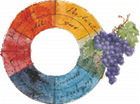Features and peculiarities of Sangiovese wines from three areas of Tuscany, obtained from grapes grown and vinified using modern biodynamic techniques
Abstract of a study presented at the 3rd International Sangiovese Symposium
Florence, Palazzo dei Congressi, December 3–5, 2008
The goal was to evaluate the applicability of vineyard management practices for Sangiovese grapes in three different areas of Tuscany, and their transformation into wine according to the principles of modern biodynamic agriculture. Modern biodynamics represents the most comprehensive application of Rudolf Steiner’s postulates, as presented in the lectures delivered to farmers in Koberwitz from June 7 to 16, 1924, by verifying and separating objectively proven results from theoretical assumptions lacking of empirical evidence.
A key requirement is the applicability of each principle to the ordinary agricultural practices of a modern enterprise. Grape production relied on a minimal number of external technical inputs, such as green manure seeds, copper and sulfur for crop protection, and lithothamnium and bentonite as processing aids. For the winemaking process, only grapes from vineyards managed biodynamically for at least three years were used, and the wine was made in wineries dedicated exclusively to this type of vinification.
Fermentations were carried out using only endogenous components of the grapes, without any chemical, biological, or physical inputs. The sole exception was the use of potassium metabisulfite, with total sulfur dioxide levels in the bottled wine ranging from 28 to 50 ppm.
The vineyard results made it possible to bring healthy grapes to the winery, with average yields of 60–70 quintals per hectare. The grapes showed analytically promising characteristics, consistently displaying excellent anthocyanin/total polyphenol and total acidity/sugar ratios, allowing for vinification without any corrections. A particularly interesting, non-conventional relationship was observed between APA (assimilable nitrogen) content in the must and the progression of fermentation.
The resulting wines, all of which underwent spontaneous fermentations with regular progress, showed no technical flaws. They were subjected to numerous blind tasting panels—often without disclosing the production methods. Both the musts and the wines were monitored analytically throughout the entire process up to bottling, and some were analyzed again two years after bottling.
A consistent balance in analytical parameters and long-term stability was observed. A peculiar trait was often the ratio between free and total sulfur dioxide. Sangiovese wines generally appeared ready to drink early, soft and free from astringent or bitter notes; they were full-bodied, with remarkable extract and high polyphenol content. The findings suggest the real-world feasibility of applying this method both in the vineyard and in the cellar. While further, more in-depth studies are needed, the positive response from average consumers is worth noting.
The Reason Behind This Website







